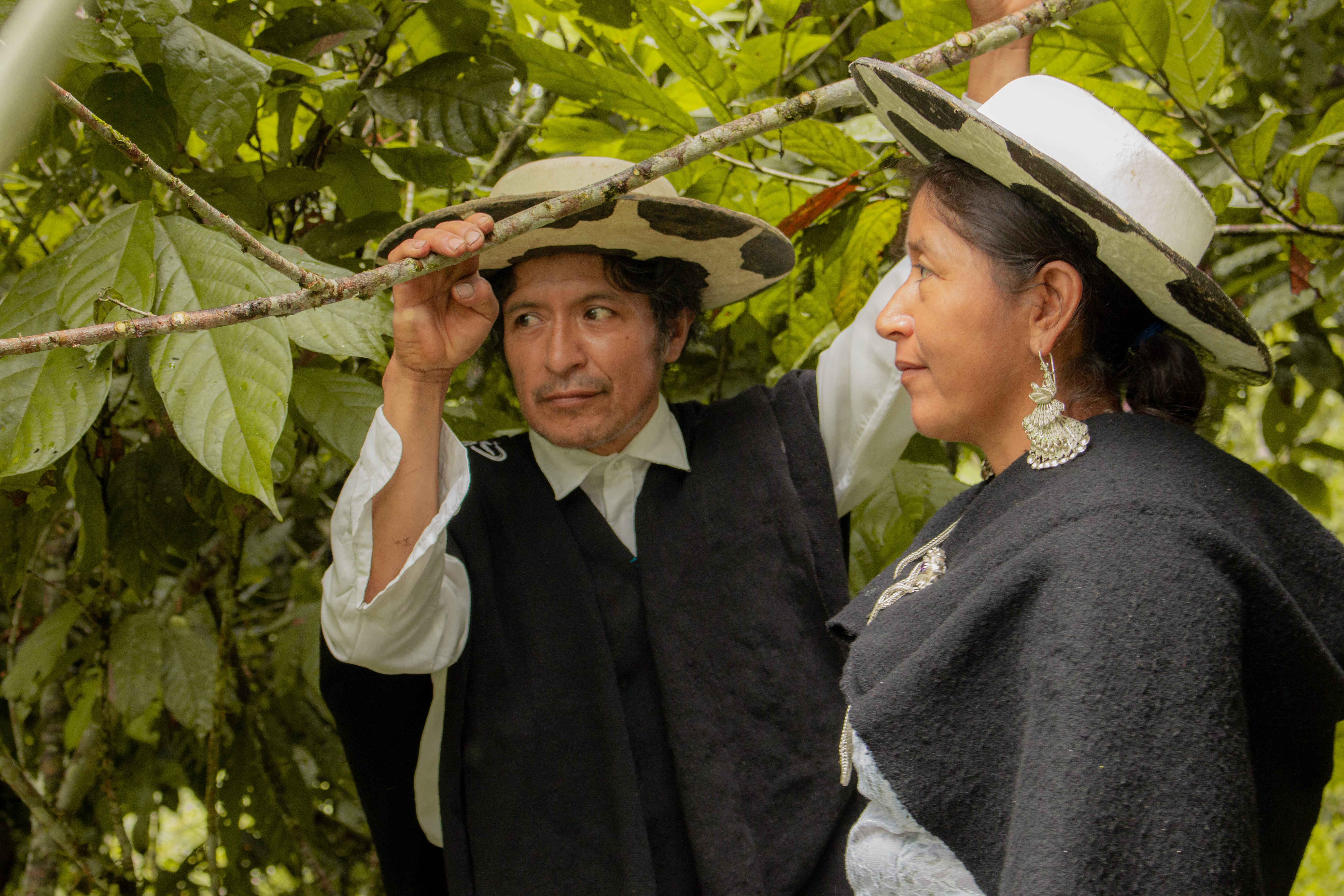
This blog draws from assessments conducted by the authors in 2022 and 2023 of REDD+ implementation in Costa Rica and Ecuador that involved field missions to and interviews with Indigenous communities in both countries. It also draws on discussions with Indigenous Peoples’ organizations from other jurisdictions where carbon credit projects have or are currently taking place, and a literature review of carbon credit projects in forests located in Indigenous Peoples’ territories.
In recent years, new and revised standards aimed at addressing significant shortcomings in environmental integrity of carbon credits have emerged.[i] Social integrity has received less attention and remains partially addressed.[ii] In the context of carbon credits generated from forests in Indigenous Peoples’ territories, ensuring social integrity means guaranteeing that carbon programs respect their internationally recognised human rights.[iii]Indigenous Peoples’ experiences to date with carbon credits and climate finance point to several necessary measures for this to be realized in the context of jurisdictional REDD+ programs. Unless these measures are fully implemented, Indigenous Peoples, including those who are not ideologically opposed to carbon programmes and projects, will increasingly oppose them through legal and quasi-legal challenges, calls for moratoria on their implementation,[iv] and demand redress for harms they cause. This blog offers an initial foray into these measures as a point of departure for their collaborative exploration with Indigenous Peoples.[v]
To ensure coherence, social integrity and climate justice, any ambiguity or lack of clarity in the wording of carbon crediting standards must be resolved consistently with international human rights law (IHRL) standards. This means that programs must not support activities “that do not comply with national law and obligations under international law, whichever is the higher standard (hereinafter "Applicable Law")” ,[vi] and all activities “recognize and foster full respect for Indigenous Peoples' human rights [including the rights of Indigenous women][vii] as recognized under Applicable Law, including but not limited to their rights to self-determination, their lands, resources and territories, traditional livelihoods and cultures”[viii].
Despite their obligations under IHRL, many States do not recognise, or only partially recognise and do not implement, Indigenous land and resources rights.[ix] This is evident in those Nationally Determined Contributions that plan to use carbon markets to realize their objectives[x]. Implementing jurisdictional REDD+ programs in such contexts could entrench this denial of land and territorial rights or serve as a lever for their recognition.[xi] These programs therefore have a responsibility not only to ensure that carbon crediting does not cause, contribute to, or compound rights violations, but to act as a catalyst for law and policy reform and acceleration of land titling and realization of self-governance rights.
Indigenous Peoples have inherent rights over carbon stored in their territories under their customary laws and the resource dimension of their right to self-determination.[xii] Carbon credit certification and verification processes should assess if these carbon rights are recognised and respected.[xiii] If they are not, the processes should clarify if the concerned Indigenous Peoples have negotiated mutually acceptable fair and equitable benefit sharing arrangements in full respect of land rights and FPIC. If neither condition is met, carbon credits in Indigenous lands should not be certified.
Issuing credits for carbon stored in Indigenous territories can have significant impacts on rights to land and resources, livelihoods and self-determination. For this reason, FPIC must be obtained through Indigenous peoples’ representative structures, in accordance with their laws, norms and practices and FPIC protocols where these exist, in the initial planning and design phases of jurisdictional carbon crediting programmes and maintained throughout their lifecycles. Decisions to withhold FPIC and decline participation must be respected by all parties. FPIC processes must ensure Indigenous Peoples, including Indigenous women, elders and youth, are fully informed about the risks and benefits of carbon programs, and can evaluate them on practical, legal and ideological grounds. This necessitates information about alternative non-market finance, and opportunities to validate baseline studies and tenure assessments, to negotiate predictable, continuous and equitable monetary and non-monetary benefits,[xiv] and to establish conditions on participation in carbon crediting programs, such as excluding buyers whose activities are deemed inconsistent with their laws, principles and cosmovisions. Failure to fulfil such conditions should constitute grounds for amending or exiting contracts or agreements.
Participatory social, environmental, and human rights impact assessments are necessary for informed consent and to negotiate fair and equitable benefit sharing arrangements. They should ensure Indigenous Peoples, including indigenous women, elders, youth and persons with disabilities, understand any potential impacts on their human rights, including land, territorial and livelihood rights, culture and ways of life as a result of credits being issued for carbon stored in their territories, including possible cumulative impacts in light of other existing, planned or foreseeable activities. The requirement applies to jurisdictional programs, where impact assessments may be strategic in nature but need to be sufficiently detailed to enable assessments of impacts at local levels, and to local or nested projects. In line with IHRL jurisprudence, impact assessments should be guided by the CBD’s Akwe: Kon Guidelines,[xv] with the option for verification by independent third parties trusted by Indigenous Peoples.
For Indigenous Peoples, along with evaluating impacts and risks to determine if, and under what conditions, to participate in carbon programs, a primary focus of FPIC processes is often to agree on a fair and equitable distribution of revenues from carbon stored in their territories. These arrangements could, for example, require transfers of an agreed volume of carbon credits to Indigenous Peoples, potentially commensurate with the carbon sorted in their forests, or guarantee a share of revenues according to a benefit distribution system that is agreed through fully participatory process. Lessons from existing and emerging experiences[xvi] in relation to the distribution of carbon market funds[xvii] should be shared with Indigenous peoples globally.
Carbon programs often arise in contexts where Indigenous Peoples’ land and resource rights are not adequately protected, their customary laws and carbon rights are not recognised, and Indigenous rights defenders are at risk.[xviii] Grievance mechanisms need to be designed with this reality in mind. Collaboration with Indigenous Peoples, and insight of those raising grievances in relation to carbon credit programs,[xix] in their design can ensure robust and culturally appropriate mechanisms suitable for addressing specific considerations related to Indigenous peoples in line with international standards.[xx]
There is increased attention on co-benefits beyond carbon revenues and on programs that focus on sustainability and reduced non-permanence risk by incentivising community maintenance of forests through financial and non-financial means.[xxi] It is essential that such certifications operate on the basis of safeguarding Indigenous Peoples’ rights and not as a substitute for rights safeguards.[xxii]
Indigenous Peoples face considerable and growing threats from actors encroaching on their lands and need substantial and sustained long term finance and concerted legal and technical support to continue protecting their forests and realize their land and self-governance rights.[xxiii] High integrity carbon credits alone will never provide sufficient protection for forests in Indigenous peoples’ territories. To maintain and enhance Indigenous Peoples’ capacity to protect their forests, large scale non-market based funding is needed for titling and protecting their lands (including their lands in conservation areas), ensuring recognition of their rights over forests in their territories, and enabling them to strengthen their governance structures and realize their developmental priorities. Indigenous Peoples need to be supported to develop and implement their own self-determined plans, priorities and visions for the future. In addition to the moral and legal imperatives to guarantee their collective rights and survival, this is one of the most cost-effective approaches to mitigating climate change.[xxiv]
For more information about UNDP’s work on carbon markets, see UNDP’s High Integrity Carbon Markets Initiative and visit Carbon Markets Work Area.
[i] Following controversies in relation to serious deficiencies in the environmental integrity of carbon projects and the impact of some of those projects on indigenous peoples, a series of new and revised standards have emerged addressing supply and demand site of carbon credit markets, see for example A New Era for Verra - Verra; Verra Verified Carbon Standard (VCS) October 2023; The Core Carbon Principles - ICVCM; ICVCM Assessment Standard July 2023; ACR Standard V8 July 2023 The ACR Standard (acrcarbon.org); Gold Standard (June 2023) Safeguard Principles and Requirements CORE DOCUMENT- (goldstandard.org), Plan Vivo Standard 5.0 (July 2022) Standard V5.0 - Documents | Plan Vivo Foundation; Architecture for REDD Transactions (ART) The REDD+ Environmental Excellence Standard (TREES) 2.0 (August 2021) TREES-2.0-August-2021-Clean.pdf (artredd.org); Climate, Community & Biodiversity Standards: v3.1 (2017) CCB Standards Third Edition, v3.1 26OCT2016 (verra.org). There has also been an emergence of third-party rating agencies such as: BeZero, Sylvera and Calyx Global that are providing analysis of the effectiveness of certification standards in ensuring environmental and social integrity see “Assessing the Quality of Carbon Credit Rating Agencies” https://carbonmarketwatch.org/wp-content/uploads/2023/09/CMW_Policybriefing_rating_raters-v2.pdf.
[ii] The social integrity aspects of carbon certification standards in the context of indigenous peoples address requirements around core issues including land tenure security, FPIC, impact assessments, benefit sharing, and grievance mechanisms. There is significant variance in how these issues are addressed across standards, with no one standard adequately addressing all areas. Few standards address indigenous peoples’ claims over the carbon stored in their territories.
[iii] The jurisprudence of UN treaty bodies and regional human rights mechanisms affirms the UN Declaration on the Rights of Indigenous Peoples (UNDRIP) is the authoritative framework to interpret core obligations under human rights treaties in relation to indigenous peoples’ collective land, territory and resources rights.
[iv] See calls for a moratorium on carbon trading projects in “Statement of the International Indigenous Peoples Forum on Climate Change in Asia during the Asia-Pacific Climate Week” November 15, 2023 KEY messages in APCW (ntfp.org), and Indigenous Peoples, Local Communities, and Trade in Terrestrial Carbon Markets: Time to Recognize Their Rights, Support Their Organizations, and Impose a Moratorium on Terrestrial Carbon Trade September 10, 2023 PACT - Position Paper on Terrestrial Carbon Markets_10_Sept_23.pdf (un.org). See calls by civil society organizations to vitiate the agreement signed between the Liberian government and Carbon Blue (with similar agreements signed by at least four other African states such as Tanzania and Zambia) on the grounds that it claims the legal rights to market forest carbon in community lands and poses risks to the livelihoods of up to one million people, risks extinguishing community land ownership, and violates peoples’ right to FPIC for developments on their lands International_Statement_on_the_Carbon_Deal_-_Carbon_Blue_and_Liberia.pdf (fern.org) and Massive carbon offset deal with Dubai-based firm draws fire in Liberia (mongabay.com). In Ecuador, a constitutional prohibition on carbon credits, means that any proposals on carbon trading in relation to Ecuador's forests should be regarded with scepticism by indigenous peoples.
[v] The blog does not advocate for carbon credits but is premised on indigenous peoples’ self-determination right to decide if and under what conditions they may or may not wish to engage with them.
[vi] UNDP SES. This requirement is recognised in Verra’s VCS Standard v 4.5 (October 2023) section 3.19.17 which requires project proponents to identify indigenous peoples and “recognize, respect, and promote the protection of the rights of said groups in line with applicable international human rights law, and the United Nations Declaration on the Rights of Indigenous People and ILO Convention 169 on Indigenous and Tribal Peoples, in project design and implementation”.
[vii] Committee on the Elimination of Discrimination Against Women (CEDAW) General recommendation No.39 (2022) on the rights of Indigenous women and Girls (26 October 2022) CEDAW/C/GC/39. UNDP’s SES also require efforts to integrate principles of inclusivity and gender equality, to promote the effective inclusion of potentially marginalized indigenous sub-groups, such as women, youth, elders, persons with disabilities.
[viii] UNDP SES Standard 6: Indigenous Peoples.
[ix] See compilation of UN treaty body jurisprudence from 1993 to 2023 available here and here. For example in Indonesia it is estimated that there are 20.8 million hectares of customary forests but only 221,648 hectares (approximately 1% of them) are officially recognized see Hans Nicholas Jong (12 October 2023) Indonesia opens carbon trading market to both skepticism and hope (mongabay.com).
[x] AIPP ‘Nationally Determined Contributions in Asia: Are Governments recognizing the rights, roles and contributions of Indigenous Peoples?’ (2022).
[xi] One of the arguments made in favour of Jurisdictional REDD+ over local carbon projects is that land rights are more clearly addressed as a result of the State involvement, see for example Polly Thompson, Carmen Alvarez Campo and Ben Rattenbury An introduction to jurisdictional REDD+ (sylvera.com) October 18, 2022
[xii] For discussions on carbon rights and customary law see Charlotte Streck ‘Who Owns REDD+? Carbon Markets, Carbon Rights and Entitlements to REDD+ Finance’ Forests 2020, 11, 959; RRI (2021) ‘Status of Legal Recognition of Indigenous Peoples’, Local Communities’ and Afro-descendant Peoples’ Rights to Carbon Stored in Tropical Lands and Forests’; Knox, A.; Vhugen, D.; Aguilar, S.; Peskett, L.; Miner, J. Forest Carbon Rights Guidebook: A Tool for Framing Legal Rights to Carbon Benefits Generated through REDD+ Programming; USAID (2012).
[xiii] Realising this will involve robust and participatory land and forest tenure assessments as part of due diligence on indigenous peoples’ rights to determine the legal owners under indigenous customary law of forests areas.
[xiv] This requires sharing information on risks associated with the financial sustainability of carbon markets.
[xv] “Akwé: Kon Voluntary guidelines for the conduct of cultural, environmental and social impact assessments regarding developments proposed to take place on, or which are likely to impact on, sacred sites and on lands and waters traditionally occupied or used by indigenous and local communities”.
[xvi] For example, in Costa Rica the National Forestry Financing Fund (FONAFIFO), a government agency, has proposed a model whereby future benefits from carbon sequestration be directly correlated with the extent of forests located in Indigenous lands, under the premise that the rights over carbon stored in those forests is vested in the concerned Indigenous peoples. In other countries, Indigenous Peoples may not wish to have benefits shared on the basis of tonnes of carbon stored in each distinct, collectively-owned Indigenous Peoples’ forests, and may instead opt for other means of sharing that they consider equitable for all Indigenous Peoples.
[xvii] See for example Costa Rica Letter of Intent signed with LEAF on 4 Nov 2021.
[xviii] For examples of harms see Mapped: The impacts of carbon-offset projects around the world (carbonbrief.org) see also: allegations of evictions to facilitate carbon trading Kenya's Ogiek people being evicted for carbon credits - lawyers - BBC News (November 2023); decision of the Colombian Court affirming the need for consultation to obtain FPIC as a result of the potential impact on indigenous peoples’ rights of carbon credit projects; allegations of gender violence in Kenya Allegations of extensive sexual abuse at Kenyan offsetting project used by Shell and Netflix | Environment | The Guardian; allegations of impacts on livelihoods, cultures and food security Blood Carbon: how a carbon offset scheme makes millions from Indigenous land in Northern Kenya - Survival International; allegations of killings in Honduras Carbon credits tarnished by human rights ‘disgrace’ – EURACTIV.com and allegations of indigenous peoples being forced off their lands in the Congo in the name of carbon credit projects. Allegations of threats and attacks against Kichwa human rights defenders in the context of carbon offset projects in the Cordillera Azul National Park in Peru Committee on the Elimination of Racial Discrimination (CERD) Early Warning Urgent Action to Peru, 28/04/2023. Conservation actors have been called upon to address this issue of threats to indigenous rights defenders, see Bille Larsen P, Le Billon P, Menton M, et al. ‘Understanding and responding to the environmental human rights defenders crisis: The case for conservation action. Conservation Letters’. 2021. A common theme raised in many of these cases is the absence of effective and culturally appropriate grievance mechanisms.
[xix] See for example complaint of the Amerindian Peoples Association (APA) to ART’s internal grievance mechanism regarding flaws in the FPIC process followed by Guyana prior to submitting its application for carbon credit certification to ART available along with the government response here.
[xx] See the UN Guiding Principles on Business and Human Rights (UNGP) minimum criteria for effectiveness of grievance mechanisms; see also related guidance of human rights bodies, such as the Expert Mechanism on the Rights of Indigenous Peoples (EMRIP) UN Doc A/HRC/EMRIP/2012/CRP.1; the UN Working Group on Business and Human Rights UN Doc UNWGB&HR A/68/279 and the Special Rapporteur on the rights of indigenous peoples UN Doc A/HRC/24/41, 2013.
[xxi] Co-benefits and Sustainable Development contributions are core criteria in the evaluations of rating agencies such as Sylvera and Calyx Global and are the focus of certification bodies, see for example Verra’s VCS Standard v 4.5 (October 2023) section 3.17 “Sustainable Development Contributions” and “ART launches initiative to capture the value of jurisdictional REDD+ beyond carbon” (27 January 2023). See Hamerkop team (November 2023) Assessing Carbon Co-Benefit Standards: Unlocking the Value of High-Quality Carbon Projects (ampproject.org).
[xxii] The distinction between co-benefits and safeguards needs to be made fully clear to indigenous peoples organizations invited to participate in the development of co-benefit certification standards.
[xxiii] See State of the World’s Indigenous Peoples, Volume 5, Rights to Lands, Territories and Resources (2021).
[xxiv] Constructive conversations could be held with indigenous peoples on how to reform donor procedures to cater to the realities of Indigenous Peoples’ organizations and ensure funding reaches them at the scale and speed they need to continue protecting their critical forests, see FPP (2022) “The Montreal Roundtable: Improving solidarity and reciprocity in funding and support relationships” available at The Montreal Roundtable: Improving solidarity and reciprocity in funding and support relationships | FPP (forestpeoples.org). See also Charapa Consulting (2023) “Directing Funds to Rights Principles, standards and modalities for supporting indigenous peoples’ tenure rights and forest guardianship”. Experiences such as CONFENIAE’s Results Based Payments project implementation plan (PDI) in Ecuador, and payment for environmental services to Indigenous Peoples in Costa Rica, offer valuable lessons and insights around facilitating direct access to funding for Indigenous Peoples’ organizations from which future climate finance projects can learn.


